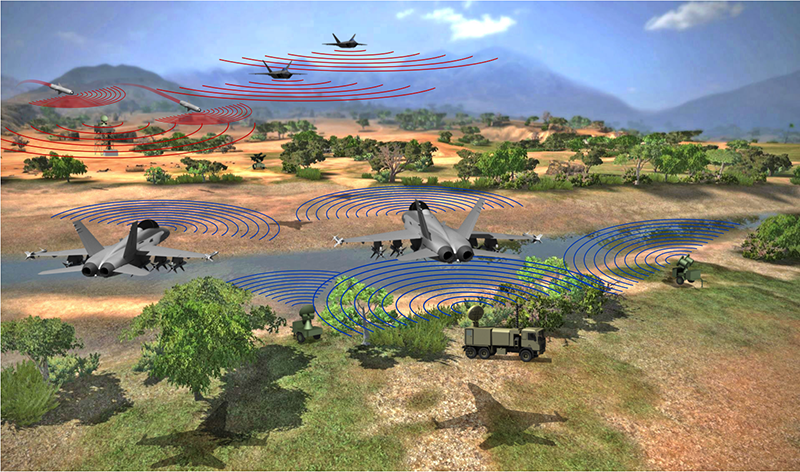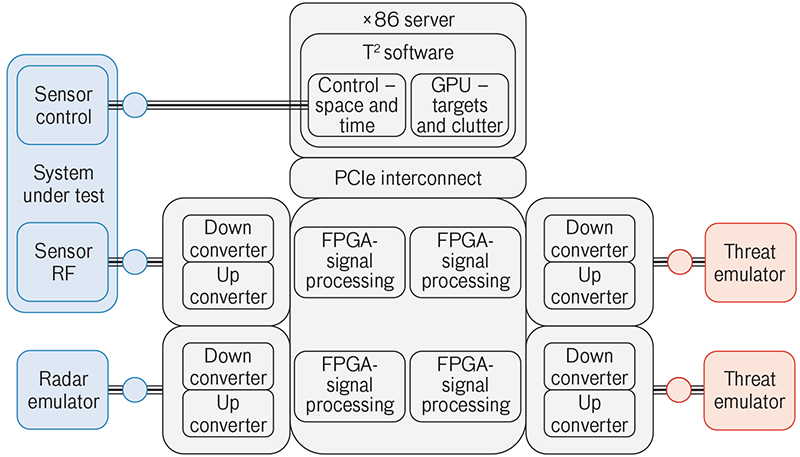tech notes
Multisystem Simulation with T2OURNAMINT
Battle theater simulation enables operational radar and electronic support systems to be pitted against jammers and missile seekers under realistic engagement scenarios.
Today's battlefield engagements occur in an increasingly congested electromagnetic environment where radar and communication systems encounter intentional and unintentional interference from many sources, such as jammers and friendly-force transmissions. These systems must simultaneously engage multiple adversaries, with each side employing complex signals and processing to engage its opponents. Typically, systems first encounter these complex threat scenarios in field-testing, long after design and manufacturing details are finalized. Realistic indoor testing is sorely needed to uncover system flaws before it is too expensive to modify designs.
 This notional modern battlespace shows multiple sensing systems on both offense and defense and a dense electromagnetic signal environment. Depicted systems include ground, airborne, and seeker radars, and fixed, escort, and self-protect electronic warfare systems.
This notional modern battlespace shows multiple sensing systems on both offense and defense and a dense electromagnetic signal environment. Depicted systems include ground, airborne, and seeker radars, and fixed, escort, and self-protect electronic warfare systems.The U.S. Navy asked MIT Lincoln Laboratory to apply its expertise in wideband sampling and low-latency signal processing to develop comprehensive multisystem, hardware-in-the-loop (HWIL) testing. Conceptually, systems under test would connect to a simulator that provides signal delays and other real-world effects, such as Doppler frequency shift and terrain clutter, equivalent to those faced in modern electronic warfare (EW). This simulated battlespace would be a dynamic environment wherein systems compete in real time as they would in the field.
The Laboratory’s solution, T2OURNAMINT (Testing Theater Operations Using Real-time Networks Achieving Multiple Interconnected Nodal Tactics), is a simulator connecting multiple systems via a signal and control hub that manages the electronic inter-system interactions defined for a test scenario. Initially, T2OURNAMINT will be applied to air defense scenarios, with an emulated radar pitted against fielded electronic attack (EA) systems. Modern air defense radars use multiple waveforms to detect, acquire, and track objects, and EA systems respond dynamically with multiple techniques to disrupt radar measurements. The T2OURNAMINT architecture must support this real-time back and forth while simulating environmental factors, such as clutter.
Hardware Architecture
The core functionality of T2OURNAMINT is provided by state-of-the-art, high-speed serial data links, fully interconnecting all sensors. T2OURNAMINT is now configured to test up to four single-channel systems. A key innovation maintains the data synchronization and fixed latency of this network, independent of the channel count and at the full system bandwidth.
T2OURNAMINT connects to each system under test (SUT) at microwave frequencies while modeling the SUT components that are not included in the simulation, e.g., transmit and receive antenna patterns, system noise figure, and front-end component gains. T2OURNAMINT's microwave down- and up-converters are connected to each HWIL sensor and can be tuned to center frequencies from 2–18 GHz, thereby supporting various military operating bands.
 The diagram of the hardware architecture for the initial, four-channel T2OURNAMINT implementation shows a single system under test, along with hardware radar and threat emulators. Systems interface to T2OURNAMINT through RF/microwave connections to converters and through software-managed digital control connections. T2OURNAMINT uses FPGAs to simulate propagation paths between connected systems, a high-end commercial server for scenario simulation, and a graphics processing unit (GPU) to simulate software targets and terrain clutter. Friendly (blue) and adversary (red) colors have been arbitrarily assigned.
The diagram of the hardware architecture for the initial, four-channel T2OURNAMINT implementation shows a single system under test, along with hardware radar and threat emulators. Systems interface to T2OURNAMINT through RF/microwave connections to converters and through software-managed digital control connections. T2OURNAMINT uses FPGAs to simulate propagation paths between connected systems, a high-end commercial server for scenario simulation, and a graphics processing unit (GPU) to simulate software targets and terrain clutter. Friendly (blue) and adversary (red) colors have been arbitrarily assigned.Firmware Architecture
T2OURNAMINT implements precise signal delay through a combination of first-in, first-out sample buffers, interpolation filters, and RF carrier phase shifting. Together these techniques provide delays of up to thousands of kilometers, enabling extended engagements, with resolution of less than a millimeter to support precision sensor measurements.
Moving objects produce additional signal propagation effects, most importantly Doppler shift. T2OURNAMINT supports single-frequency offset modulation, which is sufficient to model Doppler for most radar waveforms.
T2OURNAMINT also supports attenuation, including propagation loss and antenna gain (as a function of mechanical and electrical steering angles). The required attenuation is distributed throughout the signal path, with both hardware and firmware elements, to achieve the best dynamic range feasible.
For a complete representation of a scenario, T2OURNAMINT must account for the signal reflection from each object, including both monostatic and bistatic returns. Depending on the fidelity necessary, T2OURNAMINT can inject constant or Swerling point returns, or generate extended returns in both range and Doppler by using a novel waveform modulator.
Software Architecture
Complementing the field-programmable gate array (FPGA) implementation of fully interacting hardware platforms, T2OURNAMINT supports monostatic returns generated wholly within software and distributed returns, such as surface clutter and thermal noise. These returns are implemented on an NVIDIA graphics processing unit under control of a commercial server.
T2OURNAMINT software and hardware activity is synchronized using simulation frames. Frames encapsulate the state of the simulation at a specific instance. The frame includes object position and orientation and the rates at which these parameters change. Signal propagation parameters are calculated directly from the frame variables. The T2OURNAMINT frame generator maintains strict real-time operation to keep control over hardware devices and is synchronized to radar coherent processing intervals to ensure simulation accuracy.
Scaling to New Systems
T2OURNAMINT is scalable in several ways. First, the number of sensor connections can be increased through FPGA processor expansion and additional high-speed data interconnects. T2OURNAMINT also scales in connection quantity through multichannel digital sampling and generation hardware, generally with reduced sample rates and reduced instantaneous bandwidth.
T2OURNAMINT scales in frequency by using microwave converters that support other bands. Finally, performance scaling is possible through modular technology that replaces existing modules with
more capable equivalents or extends the architecture to new system functionality. This modularity is instrumental to periodic refresh of
T2OURNAMINT technology.
Future Directions
T2OURNAMINT, currently operating at Naval Base Ventura County, Point Mugu, California, represents a major step forward in testing RF system capabilities.
Future T2OURNAMINT applications will likely include air-to-air radar/EW engagements and mobile communications. These applications will emphasize other T2OURNAMINT capabilities, such as high pulse-repetition frequencies and short control update intervals. Additional sensor interfaces, newer generations of FPGAs, and different port configurations are under development.
Posted June 2017
top of page